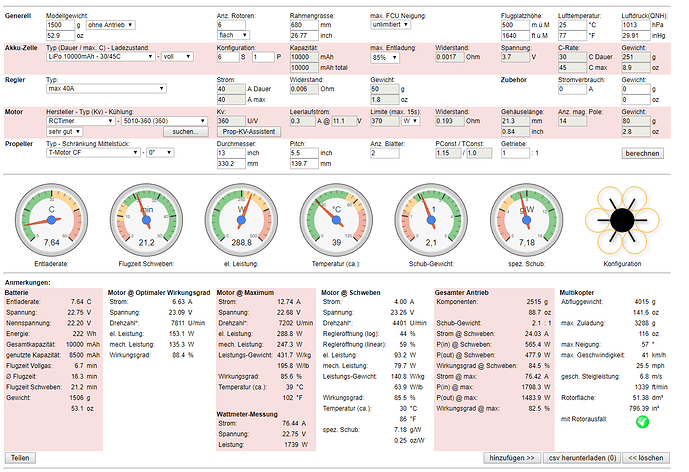IMNSHO eCalc is crap. I paid to use it and it was not even close to what I was seeing in the field.
Your power system is all wrong.
I have 5010-350Kv motors on a 662mm QUAD. I’m swinging 1655’s on 6s. Take off weight is 3315 grams. Flight time using 80% of battery capacity is 24 minutes.
I have a 680 Pro. 4006-740kv motors swinging 1355s on 2 5200mAh 4S Lipos (10400mAh total capacity) in parallel. Take off weight is 3248 grams. Flight time using 80% of the battery capacity is 18 minutes.
I tried using 5010-530Kv motors on 6S 10000mAh swinging 1355s, and the flight time increase (just under 2 minutes) did not justify the cost.
The point is, the 5010s need to be run with props between 15" and 17" on 6S, period, end of story.
Read this:
Note: This is NOT my work… Used by permission of renatoa on RCG
The attached spreadsheet with do the math for you…
I have used this for quite sometime and it has proven to be accurate to within seconds of real life performance.
"
For any platform of any size and weight, the flight time is the result of:
time = whkg / (1000*R / eff_gw) * 60, where
whkg = battery energy density, in Watt hour / kg, ranging from about 150 for the high C packs to 270 for LiIons. 10C Multistars are 185.
R = ratio between AUW and battery weight
eff_gw = motor/prop efficiency, grams per Watt, taken from mfr data.
Be aware to get from table the efficiency for the intended thrust, and for 50% throttle !
Efficiency greatly depends on load, so don’t use efficiency stated for 1kg, to compute flight time of 2-3 lg platform !
Also, don’t use values for more than 60% throttle, the platform will be unstable, no more room for motors to do their control job…
As I wrote, this formula works for ANY size platform and energy source, lets do the math for some particular cases:
Case I Ph2
battery wh/kg = 5.2(Ah)11.1V/0.37(kg) = 156wh/kg
R ratio between AUW and battery = 1250/370 = 3.4
propulsion efficiency = 11g/W
time = 156 / (10003.4 / 11) * 60 = 30 min
Case 2 the 129 min record
battery wh/kg = 266Wh/kg - typical LiIon energy density
R ratio between AUW and battery = 3.4/2 = 1.7
propulsion efficiency = 14.1g/W
time = 266 / (1000*1.7 / 14.1) * 60 = 132 min
And finally, my 30 min case
battery wh/kg = 165, I use a Zippy Compact, having a bit more energy than the average LiPo
R ratio between AUW and battery = 0.75/0.195 = 3.8
propulsion efficiency = 11g/W - using Phantom 2 clone
time = 165 / (1000*3.8 / 11) * 60 = 28 min
As you can see from the above, reasonable precision of all estimations, proving this formula is valid for any configuration, so now you have a tool that should tell you what is wrong in your setup, and where to work to improve flight time.
The biggest unknown for most users is the propulsion efficiency, for this reason I think is mandatory to not buy stuff without manufacturer precise specification of this parameter.
renatoa is offline Send a private message to renatoa Find More Posts by renatoa "
Calculate Flight Time.zip (1.2 KB)
Here are the specifications for my 680 Pro:
AUW (g) 3248
Battery Capacity (mAh) 10400
Number of Cells 4
Battery Weight (g) 895
Battery Energy Density (Wh/kg) 171.9776536
Number of Motors 6
Hover Thrust per Motor (g) 541.3333333
Motor Eficiency (g/W) 8
Expected Flight Time 22.74679803 minutes
Flight Time with 20% Reserve 18.19743842 minutes
680 Pro Bare Weight (No LiPo) 2353 grams
Turnigy 4006-740Kv
13" x 5.5" CF Props
X-Rotor 40A OPTO ESCs
Pixhawk Flight Controller
915mHz Telemetry
FrSky X8R
Tarot ‘Small’ Retracts
SJ4000 ‘clone’ camera
2 Axis Gimbal w/8bit SBGC
Tattu 4S 10400 15C
Craft&Theory Telemetry
OLED Display
Neo-M8N GPS
So then, here is the bottom line:
Unless you extend the motor arms you are stuck with using 13" props. With 13" props, using 6S is a waste of money. To get better flight time you need to find motors that will run on 4S and when swinging 13" props they will have a high g/w.
Caveats:
- Motor data charts are notoriously inaccurate because they do not accurately reflect real world performance. Bench testing anything never matches what happens “in the field.”
- There is no one solution that fits all configurations, and any one who says so should not be trusted.

